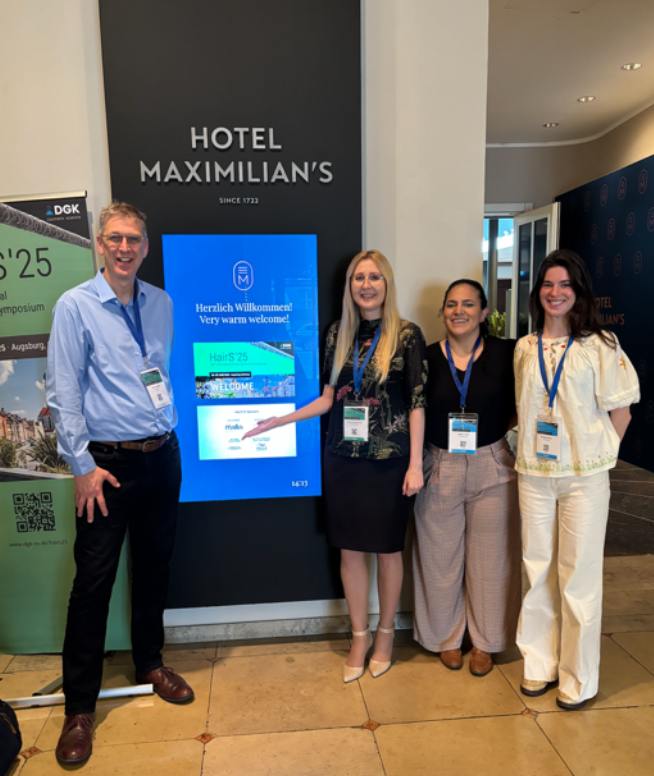HairS’25, Augsburg, Germany – A Short Review
- TRI Princeton

- Jul 17
- 3 min read
Updated: Jul 19

Dr Paul Cornwell, Director at TRI
The 24th International Hair-Science Symposium, HairS’25, was held on 25-27th June 2025, in Augsburg, Germany. TRI presented three oral presentations: Understanding the Consequences of Heat Styling: The Penetration of Sebum-Mimicking Compounds; Assessing Hair Bleaching: A Simple Approach Using Light Microscopy; and Bridging Consumer Perceptions and Technical Measurements: Assessing Hair Straightness and Alignment with Optical Imaging. More details of these presentations can be found in the TRI Library.

Pictured here are (L-R): Dr Paul Cornwell (TRI Princeton); Dr Ernesta Malinauskyte (TRI Princeton), Dr Jessica Cardenas Turner (TRI Princeton) and Murielle Mason (TRI Princeton)
It is the long-standing tradition of the hair science community in Germany to hold the biennial International Hair-Science Symposium (branded as HairS’) in different, beautiful parts of Germany each time. This year the Symposium was held in Augsburg, one of Germany’s oldest cities, located in the state of Bavaria. The canals and water systems in Augsburg are an UNESCO world heritage site, and the city is the location of the oldest public housing complex in the world, the Fuggerei, which dates back to 1516, and which is still in use today. A very enjoyable and interesting walking tour of the old city was included in the Symposium programme.
The Symposium this year was organised by the DGK GmbH, a well-established scientific education and event management company. The scientific programme was pulled together by a committee led by Dr Carl Uwe Schmidt (Wella, Germany) and was the first conference not to be run by the DWI (German Wool Institute).
The Symposium was a great success with over 120 registrations, including, mostly, attendees from Europe, but some also from North America, South America and Asia. The organising committee should be commended for pulling together a very strong programme covering hair biology, insights into hair structure, hair damage, and new methods and technologies. The event was sponsored by Mallia Aesthetics, CLR, L'Oréal and Wella. The Symposium was a 100% live, in-person event, and the well organised social programme made sure that it was an excellent event for networking and making new connections. No recordings of the presentations were made. A book of abstracts is available from the DGK.
The best paper award this year was given to Dr Giacomo Mariani (L'Oréal R&I, France) titled: ‘Decoding Hair Architecture: How Curvature is Related to Hair Mechanical and Structural Heterogeneity’. The hair science community has long been fascinated in understanding why hair is curly, and this presentation picked up this theme, exploring the structures inside the cortical cells on the inside and the outside of a hair curl, and how they change when hair is restyled. Dr Mariani presented some very advanced measurement techniques, including AFM-Peak Force Nanomechanical Mapping, and Small- and Wide-Angle X-ray Scattering. Dr Mariani’s presentation suggested that fiber bending during styling affects intermediate filament packing behaviour and the mechanical properties of cortical cells on the inside and outside of the curl.
It is difficult to pick-up on the main themes from the conference, as the presentations were very varied, but if I was to pick a new theme, I would say that hair and ageing was of greatest interest. We have known for a long time that hair gets thinner and greys with age. However, what people seem to be investigating now, is ‘why’ hair ages, and what can be done about it, in a deeper, more holistic way. This links, in my mind, with the overall mega-trend in cosmetics of health and wellbeing. Two important presentations were given in this area by two of the symposium sponsors, DSM and L'Oréal. In ‘Senolytics as a New Cosmetic Treatment for Hair Rejuvenation’, Dr Remo Campiche (DSM) described how targeted removal of senescent cells by cosmetic actives can rejuvenate the cells in hair follicles and promote hair growth. In ‘Hair Fiber Thinning Age-Associated New Insights, from Molecular-Structural to Mechanical Changes – Hair Biology’, Dr Nawel Baghdadli (L'Oréal R&I, France) described the many ways her team was investigating hair ageing in the scalp, follicles and hair fibers. Dr Baghdadli described many interesting changes occurring with age, and her team are clearly getting closer to identifying new targets for cosmetic and, perhaps, more holistic treatments.
Next year, June 2026, the International Hair Science conference moves to Red Bank, New Jersey. For more information about TRI courses and events subscribe to our newsletter.










